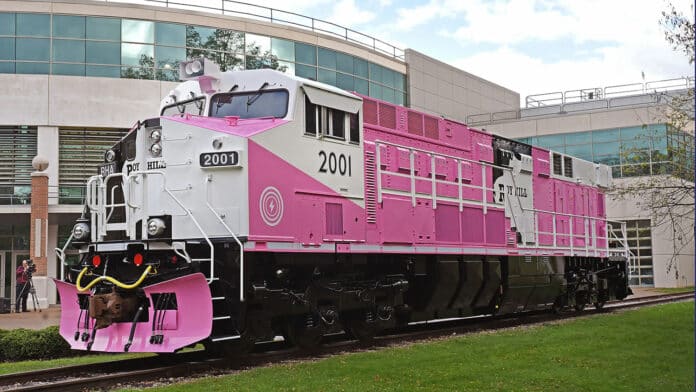Rail manufacturer Wabtec and iron ore mine company Roy Hill have unveiled the FLXdrive battery locomotive, the world’s first 100% battery-powered, heavy-haul locomotive for mainline service.
A grand ceremony was held at Wabtec’s design and development center in Pennsylvania, showcasing the unique, striking pink-colored locomotive. Roy Hill’s iconic pink livery symbolizes the company’s commitment to assisting research and those suffering from breast cancer. The iconic pink color also commemorates Breast Cancer Awareness Month.
“This FLXdrive locomotive represents a major step in the journey to a low-to-zero-emission future in the rail industry,” said Rafael Santana, President & CEO of Wabtec. “The FLXdrive is driven from within by our battery technology and the innovative spirit of our employees. Roy Hill is an ideal customer to partner with given their leadership and excellent operational record.”
Rail transport plays a vital role in moving people and goods, but it also poses serious environmental challenges. Diesel-powered trains emit large amounts of greenhouse gases that contribute to global warming and its negative consequences.
The transport sector, which includes rail, is a major source of carbon emissions and a substantial contributor to climate change. To achieve a more sustainable future, it is essential to switch to cleaner energy sources in this sector.
Electric trains, particularly the FLXdrive, are a major breakthrough for the rail industry in terms of reducing its carbon footprint. These trains run on stored electrical energy, which eliminates direct carbon emissions and reduces environmental impact. They also help to decrease the reliance on fossil fuels, mitigate air pollution, and promote a more sustainable transportation system. By using renewable energy sources for charging, these locomotives can further cut down their carbon footprint, contributing positively to efforts combating climate change.
Roy Hill’s FLXdrive battery-electric locomotive is expected to have an energy capacity of 7 megawatt hours (MWh). The FLXdrive is anticipated to provide a double-digit percentage reduction in fuel costs and emissions per train, based on the rail operations and route.
“The FLXdrive locomotive represents not only a first for the Pilbara but a first for the mining industry. The technological smarts that have gone into the development of the loco make it well suited for our rail network,” said Gerhard Veldsman, Chief Executive Officer of Hancock Prospecting Group Operations, in a statement.
“By using regenerative braking, it will charge its battery on the 344 kilometers (214 miles) downhill run from our mine to the port facility and use that stored energy to return to the mine, starting the cycle all over again. This will not only enable us to realize energy efficiencies but also lower operating costs.”
The specially designed locomotive will join Roy Hill’s existing Wabtec fleet that consists of four ES44ACi’ Evolution Series’ diesel-electric locomotives. The addition of the FLXdrive will form a hybrid locomotive capable of carrying more than 33,000 tons of iron ore typically transported by the company’s 2,7000-meter-long consists.
The FLXdrive manages the overall train energy flow and distribution through its state-of-the-art energy management software. Additionally, it comes with a unique battery thermal management system that uses liquid cooling to withstand the extreme heat of the Pilbara region, where temperatures can reach as high as 55°C (130°F).
After Wabtec completes the final battery installations and track testing, the locomotive will embark on its 17,000-kilometer (10,500-mile) journey in 2024. It will be delivered to its new home in the Pilbara region of Western Australia, which is one of the world’s premier mining precincts.
In 2021, the first version of the FLXdrive locomotive, which operated at 2.4 MW/h, was revealed to the public. It underwent a trial run for three months in California, traveling 13,000 miles (20,920 km) between Barstow and Stockton.
